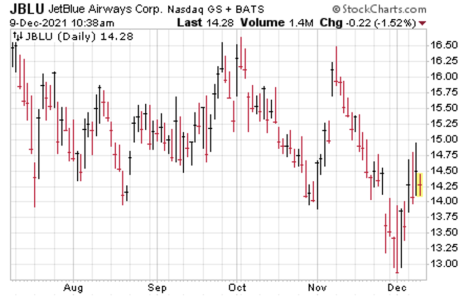We are well outside of the earnings window, but there are still a few major companies due to announce. One of those companies is JetBlue (JBLU). The company is due to announce next week and as a result, implied volatility (IV) is heightened in the near-term expiration cycle.
As many of you already are aware, when IV is inflated, options prices follow suit. So, with options prices above normal in JBLU, now is as good a time as ever to employ an options selling strategy and start selling premium.
It’s no secret that the airline industry has taken a tumble recently. And typically, as a contrarian (at heart), when stocks that play a necessary role in society tumble, I want to at least take a good hard look at the opportunity.
[text_ad use_post='261460']
The Wheel Strategy
The wheel options strategy is an inherently bullish, mechanical, options income strategy known by various names. The covered call wheel strategy, the income cycle, and the options wheel strategy are just a few of the many names that investors use. But one thing is certain: The systematic approach remains the same.
More and more investors are choosing to use the wheel options strategy over a buy-and-hold approach because it allows you to create a steady stream of income on stocks you want to or already own.
The mechanics are simple.
- Sell Cash-Secured Puts on a stock until you are assigned shares (100 shares for every put sold)
- Sell Covered Calls on the assigned stock until the shares are called away
- Repeat the Process!
Basically, find a highly liquid stock that you are bullish on and have no problem holding over the long term. Once you find a stock that you’re comfortable holding, sell out-of-the-money puts at a price where you don’t mind owning the stock.
Keep selling puts, collecting even more premium, until eventually you are assigned shares of the stock, again, at the strike price of your choice. Once you have shares of the stock in your possession begin the process of selling calls against your newly issued shares. Basically, you are just following a covered call strategy, collecting more and more premium, until the stock pushes above your call strike at expiration. Once that occurs, your stock will be called away, thereby locking in any capital gains, plus the credit you’ve collected.
Let’s go through an example using the JetBlue to show you exactly how the wheel options strategy works when trading JBLU options.
JetBlue Airways (JBLU)
Wheel Options Strategy – Step One
JBLU is currently trading for 14.28.
Let’s say we decide to go with the 14 put strike.
We can sell to open the 14 puts for roughly $0.73 to $0.74.
But before I go any further, I want to point out an important aspect of placing a trade. Never sell at the bid price and never use a market order. Always use a limit order. All research shows that taking this approach will tack on a significant percentage to your account over the long haul. Be efficient and don’t give up easy returns; work your orders!
By selling the 14 puts for $0.72 our return is 5.14% cash-secured. Our breakeven stands at 13.28 per share.
If JBLU stays above our 14 put strike at expiration we begin the process of selling puts again, thereby creating more premium to use as income or to lower the cost basis of our position. So, if we bring in 5.14% every xdays, and we can sell puts roughly eight times over the course of a year (if the stock stays above our chosen short put strike) our annual return is 41.12% on a cash-secured basis. Again, it bears repeating, we can use that capital to either produce a steady stream of income or to lower the cost basis of our position.
But what if JBLU closes below our short put strike?
No biggie. We are issued or assigned shares at the price where we wanted to buy the stock. Think about it for a sec. We collect a premium to wait for a stock to hit our chosen price.
Wheel Options Strategy – Step Two
So, let’s say JBLU closes below our 14 put strike at expiration. If so, we are issued 100 shares at $14 for every put contract we’ve sold.
Once we have shares in our possession, we begin the process of selling out-of-the-money calls against our shares, which begins the covered call portion of the wheel options strategy on JBLU.
Now the question is which strike to choose. Again, ultimately it just comes down to preference. My preference is focusing on call strikes that have a probability of success ranging from 68% to 85%.
Let’s say we decide on the selling the 16 calls against our newly issued JBLU shares for roughly $0.33 per call contract. Our probability of success on the 16 calls stands at 78.70%
Our static return or return on capital is 2.48% over 43 days.
If JBLU stays below our 16 call strike at expiration we begin the process of selling calls again, thereby creating more premium to use as income or to lower the cost basis of our position. So, if we bring in 2.48% every 43 days, and we can sell calls roughly seven times over the course of a year (if the stock stays below our chosen short call strike) our annual return is 19.84%. Again, it bears repeating, we can use that capital to either produce a steady stream of income or to lower the cost basis of our position.
But what if JBLU closes above our short call strike?
Again, no big deal. Our shares are called away, so of course, we keep our $33 per call contract, plus we are able to reap any capital gains from our stock. In this case, we would keep the $33 plus an additional $272 per share or $305 per 100 shares for a 23.0% gain.
Once our shares are called away, the wheel options strategy cycle ends, and the decision has to be made whether or not to continue using the strategy with the same stock.
The wheel options strategy is a wonderful strategy for those wanting to generate steady income, with lower risk compared to most options strategies. It also gives the investor an opportunity to lower the overall cost basis of a position.
The strategy isn’t a get-rich-quick strategy; rather, it’s a methodical, systematic approach to trading options that generate consistent returns, month after month, on stocks or ETFs that you want to hold in your portfolio over the long term.
As always, if you have any questions, please do not hesitate to email me. And don’t forget to sign up for my Free Newsletter for education, research and trade ideas.



